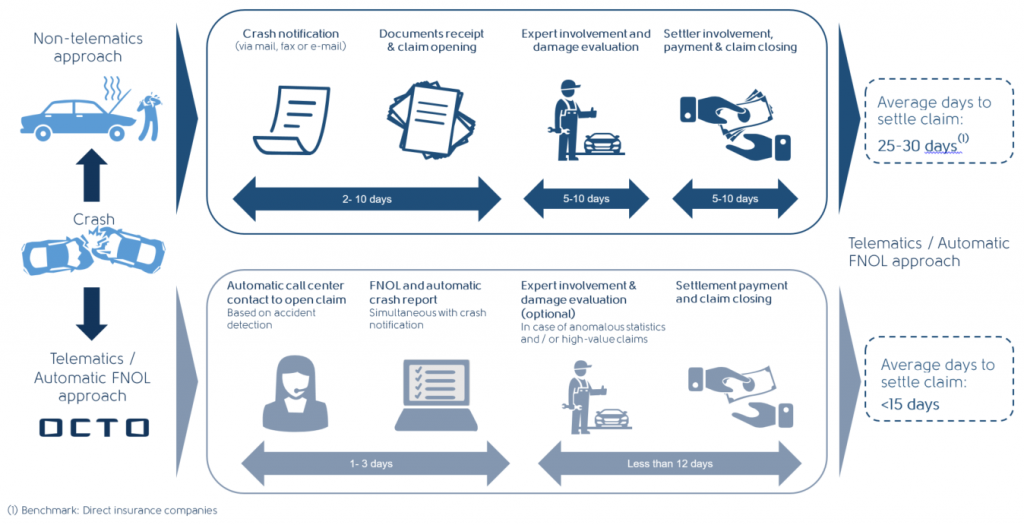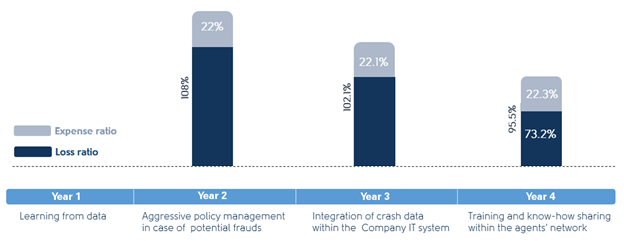
The last century has seen automobiles evolve tremendously, yet auto insurance has been slow to follow suit. Only in recent years have insurers really embraced technology that is influencing the insurance process. Auto telematics is one technology that US insurers have been rapidly adopting, mostly through usage-based insurance programs.
Telematics-driven usage-based insurance (UBI) offers major benefits to insurers and policyholders alike, but is only part of the benefit insurance telematics can offer. Since most US usage-based insurance programs use short term installation of telematics devices, they miss out on a lot of the value telematics can offer to both insurers and policyholders.
Why Your Policyholders Want Telematics-Driven Claims
Most policyholders care about three things when it comes to auto insurance: paying the lowest possible price, peace-of-mind, and good customer and claims service. Insurers spend billions of dollars each year trying to differentiate themselves as the leader in one of these three categories. Insurance telematics may be the best way to improve both your commercial and personal lines offerings along all three dimensions in a way that makes a difference to your policyholders and potential customers.
When you think of insurance telematics, you probably think of usage-based insurance. UBI programs track how, when, and in what context a vehicle is driven and tailor premiums to driving behaviors, offering discounts of up to 40% to the safest drivers. These programs, which can be built off data as simple as miles driven or as complex as customizable risk event reporting, are attractive to price-sensitive policyholders, those who are comfortable with technology, and those who identify themselves as “safe” drivers. By more appropriately pricing risk, insurers can reduce premiums and more effectively compete on price for preferred risks that self-select into the program.
UBI programs are just scratching the surface of insurance telematics potential. Instead of only being leveraged during the customer acquisition phase, telematics can be used during the customer servicing and retention phases to furnish drivers with additional services such as location and time-based services, roadside or emergency assistance, vehicle health and maintenance reminders, and automated claim reporting. For policyholders, knowing where their vehicle is, its health, and that emergency assistance is available in the event of a crash has a significant and positive impact on their peace-of-mind. According to the Usage-Based Insurance: US Consumer Survey from WillisTowersWatson, 72% of people who are interested in usage-based insurance would be willing to pay for these value-added services. Including services beyond driver scoring in a usage-based insurance program improves policyholder engagement and satisfaction, leading to higher retention rates.
As an example, J.D. Power found that it takes between thirteen and eighteen days from the time a loss is reported until the claim is paid, depending on severity. With telematics, your claims department can be notified of the crash immediately and provided with a crash dossier in virtual real time to help begin processing the claim. In this way, the crash-to-settlement timeline can be shortened by up to 50%. One of the major benefits of telematics to your policyholders in the claims process is an insurer’s ability to better identify and assign fault. Crash dossiers provide a much clearer view of an accident than traditional methods, quickly providing insurers with the evidence they need to assign fault and protecting innocent drivers from false claims.

Faster claims processing benefits not only the insurance company, but also their policyholders. A report from J.D. Power shows that “satisfaction with the claims experience impacts customer retention and referrals.” 83% of those who had the best claims experience reported they “definitely will” renew their policies. 84% would recommend their insurer. For those that had the worst claims experience, only 10% would renew with or recommend their insurer.
Why You Need Telematics-Driven Claims
If having happy policyholders isn’t enough reason to bring telematics-driven claims to your company, there are other significant benefits for insurers. Most notably, insurance telematics has been shown to improve an insurer’s combined ratio 15-20%. This happens through a combination of reduced claims frequency and severity, improved expense ratio due to enhanced processing, and increased policyholder acquisition and retention.
How Can You Leverage Telematics for Claims?
Find out in this Report.
The largest cost drivers for auto lines are claims and related expenses. Small changes in either have a major impact on an insurer’s profitability. The loss ratio on auto lines are notoriously high, bordering on unprofitable. In 2015 the average loss ratio (the percentage of premium paid in claims) for personal auto lines was 78% while the average combined ratio (percentage of premium paid in claims and expense) was just over 100%. Compared to non-telematics policies, telematics insurance policies result in 50% fewer claims on average, resulting in much more profitable policies.
Auto telematics significantly reduces the frequency and severity of claims by enabling safer driving resulting in fewer crashes, helping identify fraudulent claims, and reducing legal costs associated with contested claims. In the event of a crash, a driver’s installed telematics device can capture data from the vehicle and many key sensors. This first notice of loss (FNOL) data is transmitted real-time to the insurer in a crash dossier that provides all the relevant data needed to understand what happened such as location, severity of the accident, impact points, and speed at collision. Since first notice of loss is immediate, the insurer can reach out to the impacted policyholder and send emergency responders to the scene, if needed, and potentially reduce costly bodily injury claims. A comprehensive crash dossier helps insurers identify and combat fraudulent claims. The same data is helpful in establishing fault in a crash and reducing legal costs associated with contested claims. Finally, as evidenced through the Hawthorne effect, drivers who are monitored through a telematics device (and who get a discount for good driving) drive more safely. These factors lead directly to reduced claims frequency.
Technology is a cornerstone of process improvement, and an integrated telematics program is no different. When drivers have an Octo telematics device installed, insurers can receive automated notifications when an accident occurs. Concurrently, insurers also receive an automatic crash report they can use to start the claims process. For crash and claims services, it is particularly important for insurers to work with a telematics service provider which has enough data to accurately identify when a crash has occurred and to provide the insurer with actionable data for use in the claims process. Octo’s crash model, for example, has been independently verified as 94% accurate with no false positives.
With US auto insurers spending billions of dollars per year on advertising, it is clear that policyholder acquisition and retention is a major force in the US auto insurance industry. Price competition is a major driver of new business, but great customer satisfaction and piece-of-mind drive retention. A policyholder’s experience during the claims process has a major impact on how they view their insurer. According to Bain and Company “of the types of interactions customers have with their carrier, claims events have the biggest influence on Net Promoter Score (NPS).” Since NPS is strongly correlated with retention, and retention with long-term profitability, it makes sense to ensure that your policyholders have a positive experience during their claims process. By speeding up the claims process, removing potential barriers to claim settlement, and automating time-intensive parts of the claims process, integrating auto telematics into your claims process is the perfect way to improve your customer relationships.
A Case Study
Octo Telematics began working with a leading European insurer on bringing a fully integrated telematics program to the company. Over the course of a three-year collaboration, the insurer saw significant improvement for their telematics policies, including a reduction in claims frequency of 15.9%, a 2.6 percentage point decrease in the amount of time taken to process a claim, and an increase in average premiums of 3.1%. These improvements, along with other benefits realized through telematics, helped this insurer improve their auto insurance combined ratio from 108% to 95.5%.

The 12.5 percentage point combined ratio improvement resulted from an aggressive telematics adoption program. During the first year, the insurer expended significant effort to learn from the new telematics data, developing a deep understanding of their policyholders’ driving behavior, risk events, and crashes. Year two was largely focused on proactively addressing and reducing costs associated with fraud. The company integrated telematics crash data into their internal systems in year three, allowing the claims management team to more holistically manage a claim. Finally, Octo worked with the company to train key stakeholders (e.g.: agents’ network, repair body shop, regional teams) and ensure they maximized their benefit from telematics.
Making the Case
A comprehensive insurance telematics program can help improve your relationship with your existing policyholders and attract new policyholders while providing clear business benefits for your organization. Whether your company is just getting started in insurance telematics, or ready to expand your program beyond usage-based insurance, it’s best to find the telematics service provider who can help you now and in the future.
To learn more about how to leverage telematics to improve claims, read this report from Strategy Meets Action.
